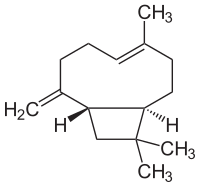
Photo from wikipedia
The current methods of treating toxoplasmosis have a number of side effects, and these therapies are only effective against the acute stage of the disease. Thus, development of new low… Click to show full abstract
The current methods of treating toxoplasmosis have a number of side effects, and these therapies are only effective against the acute stage of the disease. Thus, development of new low toxicity and efficient anti-Toxoplasma drugs is extremely important. Natural products are important sources for screening new drugs; among them, essential oils (EOs) have efficacy in anti-bacterial, anti-inflammatory, anti-insect, and other aspects. In this study, 16 EOs were screened for their anti-T. gondii activity. Lavandula angustifolia essential oil (La EO)was found to have an anti-parasitic effect on T. gondii. The cytotoxicity of La EO was firstly evaluated using the MTT assay on human foreskin fibroblast (HFF) cells, and then the anti-T. gondii activity was evaluated by plaque assay. Finally, the invasion experiment and electron microscope observation were used to study the mechanism of La EO in anti-toxoplasma activity. The results indicated that the CC50 of La EO was 4.48 mg/ml and that La EO had activity against T. gondii and the inhibition was in a dose-dependent manner under safe concentrations. La EO was able to reduce T. gondii invasion, which may be due to its detrimental effect on changes of the morphology of tachyzoites. These findings indicated that La EO could be a potential drug for treating toxoplasmosis.
Journal Title: Frontiers in Cellular and Infection Microbiology
Year Published: 2021
Link to full text (if available)
Share on Social Media: Sign Up to like & get
recommendations!